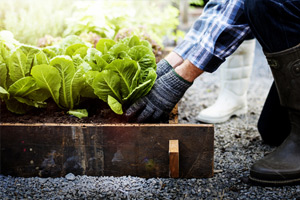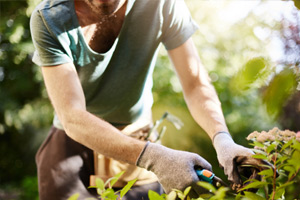 For those of you out there with a green thumb, you have likely been spending the cold winter months waiting for the weather to warm up so you can get started on planting and gardening. Now that it is time to prepare your gardening space for the blooms of springtime, there are a few steps that you should follow to ensure that you get everything ready in time. Discover how to prepare your garden soil.
For those of you out there with a green thumb, you have likely been spending the cold winter months waiting for the weather to warm up so you can get started on planting and gardening. Now that it is time to prepare your gardening space for the blooms of springtime, there are a few steps that you should follow to ensure that you get everything ready in time. Discover how to prepare your garden soil.
Before you ever put your garden hoe or shovel into the ground, you need to make sure that all these steps are taken care of so you have the best chances of seeing a well-grown garden when the blooming begins. Improper preparation could mean that, even after all your hard work and time, your garden does not look as great as it could.
If you are trying to get ahead of the spring so that you will be ready for the planting season when it begins, starting now will help keep you on track. Here are some things you should know about preparing your garden for spring.
Prepare Your Shed
Early in the year, when not many people are scrambling to prepare their garden, is the optimal time to prepare your garden soil. Whether you require fertilizer, plant supports or mulch, get them well before you will be using them so you have them on hand. Getting the supplies you need ahead of time will let you rest easy knowing that you have all you need to stay on track.
You also should take this preparation time to sharpen the tips of all your gardening tools to ensure they are sharp when you begin gardening. Also, putting oil on all of the hinges and building any tomato hinges that you might need are good things to do as well. These things could slow you down when you start gardening, so doing it ahead of time is beneficial.
Remove Anything That Is In Your Way
After a full winter, you may have some weeds that have grown too much and need to be pulled up. Getting rid of these weeds now will only help you out later on, so taking care of them now is a great way to prepare your garden.
If left unattended, weeds will germinate and cause other weeds to compete against the new plants that you are trying to grow. These weeds may even cause your plants to stop growing if they start to take over. So, make sure there are no weeds or seeds leftover that could come back to hurt your plants later. You should also rake away any fresh mulch that has not been incorporated into the soil.
Prune Your Plants
Pruning is an important part of gardening, and it can make a big difference in how big and healthy your plants will grow. If you begin this process early in the new year and complete it by early spring, then you will have a clearer view of the structure of the branches. This will allow you to begin shaping the plants so they grow out the way that you want them to before they become set in their growth pattern.
While you are pruning, you need to remember to sterilize your tools before every snip. To do this, you should use a rag with rubbing alcohol to wipe the blade after each cut. Doing this will help keep the tools from spreading disease among different plants in your garden. You should also put a bit of fertilizer on the soil to help speed up the healing process.
Prepare Your Garden Soil
 As the winter ends, the warmth of the springtime weather will enable you to start loosening up the soil for planting. You can do this by using a sharp spade or tiller to work into the soil so that it mixes the soil with the mulch. This will soften up the soil and allow you to start planting as soon as the weather allows for it rather than waiting for the soil to warm up.
As the winter ends, the warmth of the springtime weather will enable you to start loosening up the soil for planting. You can do this by using a sharp spade or tiller to work into the soil so that it mixes the soil with the mulch. This will soften up the soil and allow you to start planting as soon as the weather allows for it rather than waiting for the soil to warm up.
You will want to add some compost to the soil as well. Depending on the type of soil and what the pH balance is, you will need to add different additives. You can test a small patch of the soil to see what the dirt needs to be its healthiest, and then add those ingredients to ensure best chance of a full garden. Provide all the nutrients that the soil needs, and your plants will grow better.
Indoor Planting
If you know that you want to start growing some plants indoors, then this is the time to begin that process. Many vegetables can be grown very well in indoor conditions and be transplanted outdoors when the weather becomes warmer. This allows you to start growing the plants even when you are not able to use the garden. You can even do this with trees and shrubs, as long as they do not grow too quickly.
Add Mulch Often
Mulch can be added to plants in order to keep weeds from getting rooted and becoming a bigger problem later on. Apply mulch often and you will likely be able to catch the weeds before they start to sprout and keep them from growing in the first place. This will make weeding a much easier job later and keep your plants from having to compete with the weeds for nutrients and space.
In areas where you have done some pre-planting indoors and will transplant the plant into the garden soil, you will want to make sure that the area is well-coated so that weeds won’t start growing before the plant is introduced. This can keep weeds from growing and germinating so you will not have to deal with them once the plants are put in.
Contact the Experts at Dirt Connections
No matter what stage of garden preparation you are in, you will likely require dirt. Contact the experts at Dirt Connections to acquire the dirt you need and arrange delivery. Dirt Connections will take care of getting the dirt to you and placing it wherever you need it so that you do not have to worry about it. Contact Dirt Connections today for any questions about different dirt or soil types or to arrange a delivery.
The steps above ensure how to prepare your garden soil.












































